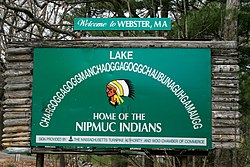Loup languages
Loup is a term which refers to the Algonquian language varieties spoken in colonial New England as attested in the manuscripts of mid-eighteenth century French missionaries.[1] It was attested in a notebook titled Mots loups (literally translating to 'wolf words'), compiled by Jean-Claude Mathevet, a priest who worked among Algonquian peoples, composing of 124 pages.[2] Loup ('Wolf') was a French colonial ethnographic term, and usage was inconsistent. In modern literature, Loup A refers to the varieties described by Mathevet, and Loup B refers to those described by François-Auguste Magon de Terlaye.[1] ClassificationLinguist Ives Goddard identified three distinct language varieties each attested in the Loup A and Loup B manuscripts. The languages of Loup A are referred to as Loup 1, Loup 2, and Loup 3; the languages of Loup B are referred to as Loup 4, Loup 5, and Loup 6. According to Goddard, Loup 3 and Loup 4 are the same language.[1] On the basis of morphophonological comparisons with other Algonquian languages and ethnogeographic context, Goddard identifies the five Loup languages with particular bands of the Pocumtuck Confederacy:[1]
 PhonologyThe phonology of Loup A [1] (Nipmuck), reconstructed by Gustafson 2000:
The vowel sounds likely have the same phonetic quality as other southern New England Algonquian languages. The short vowels /i o e a/ may represent the sounds as [ɪ], [ʊ], [ɛ, ə], and [ʌ], while the long vowels /iː/, /oː/, and /ã/ correspond to /i/, /o/, and /ã/.[2][3] References
External links
|
||||||||||||||||||||||||||||||||||||||||||||||||||||||||||||||||||||||||||||||||||||||||||||||||||||||













